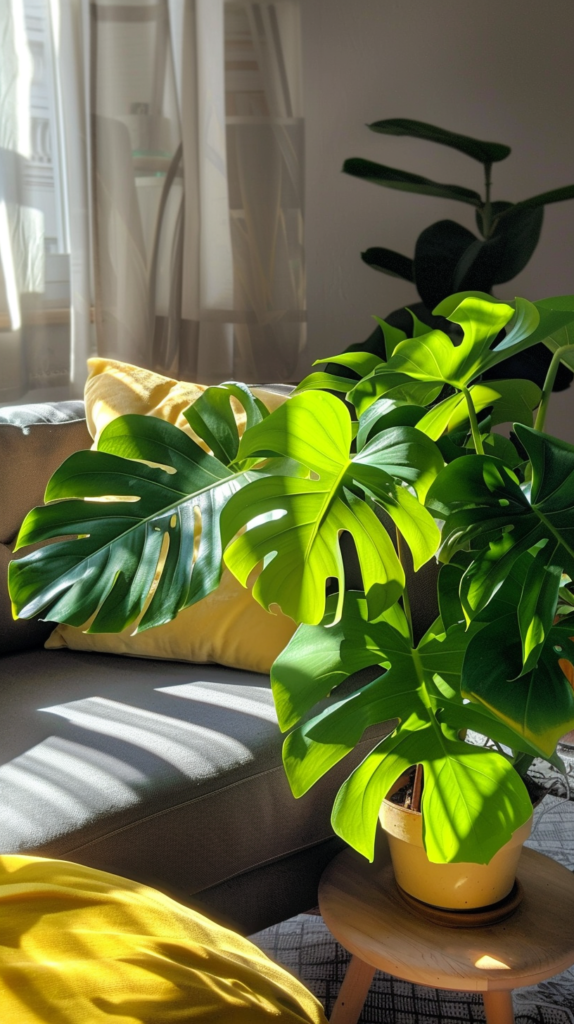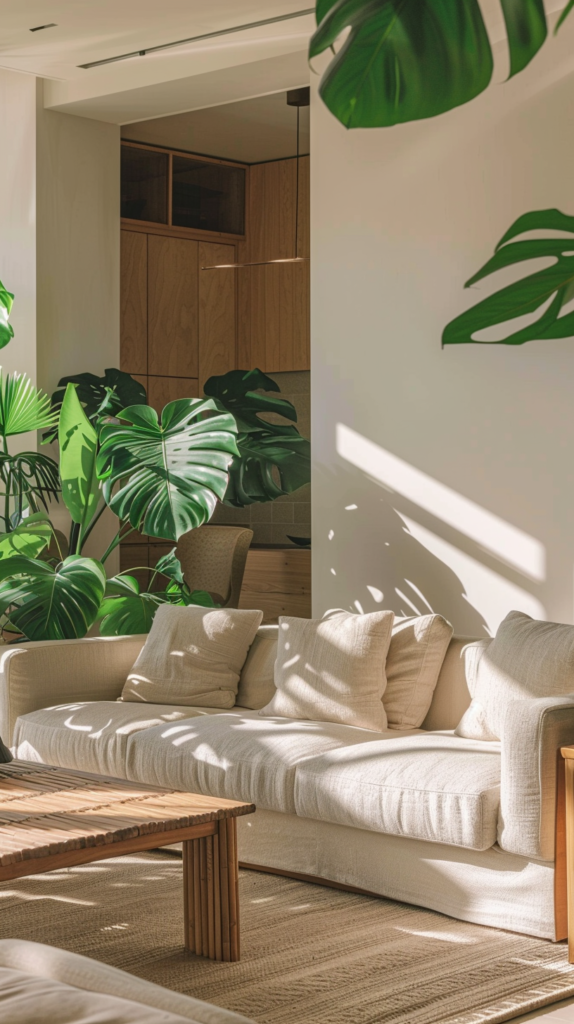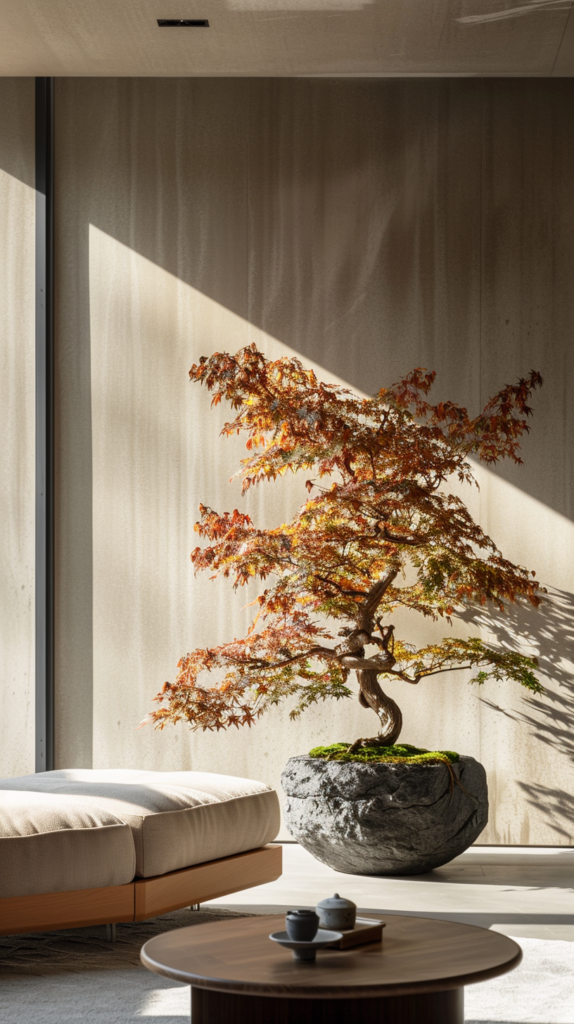Disclosure: Some links on this site are affiliate links. As Amazon Associates, we earn from qualifying purchases (at no cost to you).
Japandi home decor, a blend of Japanese minimalism and Scandinavian functionality, thrives on simplicity, natural elements, and serene environments. House plants are an essential part of this aesthetic, bringing life and tranquility into the space.
Here are the 10 best house plants to complement your Japandi home decor.
10 Best Plants For Japandi Home
1. Fiddle Leaf Fig (Ficus lyrata)
The Fiddle Leaf Fig is a popular choice for Japandi interiors due to its large, lush leaves and elegant appearance. Its bold, sculptural form adds a touch of drama to the minimalist aesthetic.

Place it in a simple, neutral pot to let the plant’s natural beauty shine. Ensure it receives plenty of indirect sunlight and water it when the top inch of soil is dry.

Fiddle Leaf Figs can grow quite tall, making them perfect for filling empty corners or creating a focal point in your living room. They thrive best in a stable environment, so avoid moving them around too much. If you notice the leaves getting dusty, gently wipe them with a damp cloth to keep them looking their best.
2. Monstera Deliciosa
Monstera, also known as the Swiss Cheese Plant, is loved for its unique, perforated leaves. Its striking foliage brings an exotic touch while still fitting within the clean lines of Japandi decor.

Position it in a bright spot with indirect light and water it moderately. Monstera’s vibrant green leaves can make a bold statement in a minimalist setting.

Monsteras are known for their rapid growth and can quickly become the centerpiece of your room. They also adapt well to indoor environments, making them a versatile addition to your home. To encourage healthy growth, provide a support structure like a moss pole, which can help the plant grow upright and maintain its stunning leaf shape.
3. Snake Plant (Sansevieria trifasciata)
The Snake Plant is perfect for those who want low-maintenance greenery. Its tall, upright leaves and hardy nature make it ideal for Japandi homes.

It thrives in a variety of lighting conditions and requires minimal watering. Place it in a simple pot to enhance its architectural appeal.

Snake Plants are incredibly resilient and can withstand periods of neglect, making them ideal for busy individuals. They also improve indoor air quality by filtering toxins, providing a healthier environment. To keep your Snake Plant thriving, water it sparingly and allow the soil to dry out completely between waterings.
4. Bonsai Tree
Bonsai trees embody the Japanese tradition of cultivating miniature trees and can add a touch of zen to your home. These trees are both decorative and symbolic of patience and care.

Position your bonsai in a spot with plenty of light and water it regularly, keeping the soil moist but not waterlogged. Their intricate forms and delicate foliage are perfect for enhancing the Japandi aesthetic.

Caring for a bonsai tree requires dedication and attention to detail. Regular pruning, proper watering, and occasional repotting are essential to maintain its shape and health. Bonsai trees come in various species, each with unique care requirements, so choose one that fits your lifestyle and commitment level.
5. ZZ Plant (Zamioculcas zamiifolia)
The ZZ Plant is another excellent low-maintenance option. Its waxy, dark green leaves are both attractive and durable.

It can thrive in low light and doesn’t need frequent watering, making it ideal for busy households. Its sleek, glossy leaves add a modern touch to your Japandi decor.

ZZ Plants are known for their ability to thrive in a range of conditions, including low light and dry air. They grow slowly, so they don’t require frequent repotting. To keep your ZZ Plant healthy, place it in a well-draining pot and water it sparingly, allowing the soil to dry out between waterings.
6. Japanese Maple (Acer palmatum)
For a touch of traditional Japanese elegance, consider a Japanese Maple. Its finely divided leaves and graceful form can bring a serene and sophisticated feel to your living space.

While more commonly grown outdoors, small varieties can be cultivated indoors in bright, indirect light. Ensure the soil stays consistently moist.

Japanese Maples are known for their stunning foliage, which can range from green to red, depending on the variety. These trees require a bit more attention and care, especially when grown indoors. Regular pruning, proper watering, and occasional fertilization are key to maintaining their health and beauty.
7. Peace Lily (Spathiphyllum)

Peace Lilies are known for their beautiful white blooms and dark green leaves. They add a touch of elegance and purity to any space.
These plants thrive in low to medium light and prefer consistent moisture. Their graceful flowers and lush foliage can enhance the tranquility of a Japandi interior.

Peace Lilies are also excellent air purifiers, removing toxins from the air and improving indoor air quality. To keep your Peace Lily thriving, water it regularly, ensuring the soil remains moist but not soggy. Mist the leaves occasionally to increase humidity and prevent browning tips.
8. Asparagus Fern (Asparagus setaceus)
The Asparagus Fern, with its feathery foliage, adds a light and airy feel to your home.
Its delicate, fern-like leaves bring a soft texture that contrasts beautifully with clean lines and hard surfaces. It prefers bright, indirect light and regular watering to keep the soil evenly moist.

Asparagus Ferns are relatively low-maintenance but do appreciate a bit of extra humidity.
Place them in a location with filtered sunlight and mist the leaves regularly to prevent them from drying out. Prune any yellowing fronds to keep the plant looking fresh and vibrant.
9. Bamboo Palm (Chamaedorea seifrizii)
Bamboo Palms are excellent for bringing a tropical touch to your Japandi decor. Their tall, slender fronds create a natural, elegant screen.

They thrive in indirect light and like to be kept evenly moist. Their vertical growth habit can add height and structure to your living space.

Bamboo Palms are relatively easy to care for and can grow quite tall, making them ideal for filling vertical space in your home. Ensure they receive adequate light and water regularly to keep the soil moist but not waterlogged. These palms also help purify the air, adding to the overall health and wellness of your home environment.
10. Bird’s Nest Fern (Asplenium nidus)
The Bird’s Nest Fern is unique for its crinkled, wavy leaves that radiate from a central rosette. Its lush, green foliage adds a vibrant yet calming touch.

It prefers medium to low indirect light and consistent moisture. This fern’s distinctive look makes it a striking addition to any Japandi-inspired room.

Bird’s Nest Ferns thrive in humid environments, so consider placing them in a bathroom or using a humidifier nearby. They require regular watering, ensuring the soil remains consistently moist but not soggy. Avoid direct sunlight, as it can scorch the delicate leaves.
FAQ
Q: How do I choose the right plant for my Japandi decor? A: Consider the plant’s form, texture, and maintenance needs. Opt for plants with clean lines, interesting shapes, and that can thrive in your home’s lighting conditions. Also, think about the plant’s growth habits and whether it fits well within your space.
Q: How often should I water my Japandi house plants? A: Watering needs vary by plant, but a general rule is to water when the top inch of soil is dry. Overwatering can be as harmful as underwatering. Check each plant’s specific requirements and adjust your watering schedule accordingly.
Q: Can I mix different types of plants in my Japandi decor? A: Yes, mixing different plants can add variety and interest. Just ensure they have similar care requirements and complement the overall aesthetic. Combining plants with different textures and forms can create a dynamic and visually appealing space.
Q: What type of pots work best for Japandi plants? A: Simple, neutral-colored pots made from natural materials like clay, stone, or wood work best. They should enhance, not overpower, the plant. Consider the size and shape of the pot to ensure it fits well within your decor and provides adequate space for the plant’s roots to grow.
Q: How do I keep my plants looking their best? A: Regularly dust the leaves, prune dead or yellowing foliage, and ensure they get the right amount of light and water. Healthy plants will thrive and enhance your decor. Additionally, rotate your plants occasionally to ensure even growth and exposure to light.
Final Thoughts
Incorporating house plants into your Japandi home decor is a wonderful way to bring life and tranquility into your living space.
Choose plants that complement the minimalist and natural elements of Japandi style and ensure they receive the proper care to thrive.
With the right selection, your home can become a serene sanctuary filled with natural beauty. Happy decorating!













